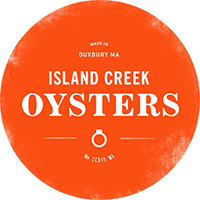I drag an eight afoot tin skiff to the waterline two hours before low tide. I load the skiff with the tools of my trade: a black fish tote, a five gallon bucket, a smaller bucket with the bottom cut out, mesh shellfish bags, and a few six-tined clam rakes. I row the skiff across a river to a mud flat that is slowly exposed as the tide recedes. I unload my gear into the tote and haul it behind me until a find an adequate spot. Anywhere is good on this flat. It’s close to ten acres and has produced good amounts of clams over the last few years. I get in an athletic stance (feet shoulder width apart, knees bent) and begin to rake. I sink the rake two or three inches into the earth, pull back on the handle and flip the mud. I pick through the overturned mud and find four clams. I toss them in the bucket.
Quahogs (also called hard shell clams) can be found in bays and tidal flats up and down the east coast. Early in our country’s history Native Americans not only used the meat as a food source but also fashioned the purple interior of the shell into a local currency called wampum. It was likely that quahogs were served at the first Thanksgiving.
After twenty minutes or so the bucket is full. I pull a nylon mesh bag around the smaller bucket and pour the clams into the bag. I go back to work. As I dig, my mind empties and soon I’m digging steadily and thinking about very little. I move forward in a crouched position leaving a trench of turned over mud behind. This work isn’t for everyone, it’s the definition of stoop labor, but for certain independent types who likes being outdoors there’s nothing better. As I dig the tide recedes further and more area become available to work.
There are many different methods of harvesting quahogs. The way a bay is structured and the rate and heights of tides will dictate the best method. Hand digging or “flipping mud” is the method described above and the one I use most often. Basket raking involves using a long handled rake with a nine toothed wire basket at the end. The clam digger works in the water during an outgoing or incoming tide and scratches the bottom for clams. He uses a container rigged to float and as his fills the basket, dumps the contents into the floating container. He is done when the tide rises above the level of his waders. Bull raking is the most involved method of quahog digging. Bullrakes are used in deeper water and deployed from a larger skiff. A bullrake has a large basket with twenty or more teeth attached to a pole that might scope anywhere from fifteen to sixty feet. The rakes are more cumbersome then simple hand rakes and the art of bullraking is one learned over many years. I prefer the simplicity of hand digging.
I stop every twenty minutes or half hour to empty my bucket into a bag. After two hours the tide is slack and then turns and begins to rise. As the tide comes I dig faster, a natural response to the incoming water. I dig my limit, a mixed batch of chowder, top-neck and littleneck clams in about three and a half hours. I row back across the river and reload the equipment, skiff and clams. As I load the clams on the truck, I make sure they are tagged according to environmental police standard and covered and kept at the right temperature according to FDA standard. I sort the clams by size; littlenecks and topnecks counted into one-hundred piece bags and chowder clams put in a crate to be sold by the pound.
Most people dig clams as a supplementary income; clam diggers might also landscape, do construction or fish for other species when the clamming is no good. The market for wild harvest clams has been affected by the recent explosion of shellfish farming. Quahog aquaculture allows farmers to control their stock and the market is sometime flooded with cheaper, lesser quality clams. In a side by side comparison wild harvest clams have a saltier, more robust meat then their coddled farm raised cousins.
Daylight and low-tide cycles in the winter months line up less often and I find my workdays cut in half at this time of year. I’m shut out of some spots that are only reachable by rowboat and have become covered with thick icebergs. I’m banished to the shoreline for many afternoons, scrapping as the tide recedes late, only leaving me an hour or so to dig. If I stay at it, dig as many low-tides as possible, I can make ends meet.
An important part of clam digging is “looking around.” In a wild harvest fishery there is a finite amount of clams in a certain area. It’s vital to spend some days walking on the shoreline, in the marshes, and along the beaches, digging prospecting holes and finding areas rich in clams for future use. It’s especially helpful to know the shoreline in the winter and be able to find a spot that is in the lee, so no matter which way the wind blows you can avoid the wind-chill.
My day ends at Island Creek’s wholesale company just a few miles from my home. The guys here are always glad to have local clams. Like oysters, clams from Duxbury Bay are well regarded for their healthy, salty meats. As I back my truck up to unload, I’m already thinking about tomorrow, hoping the tide and light and weather will line up for another day.
★ Peter Ciccarelli ★



